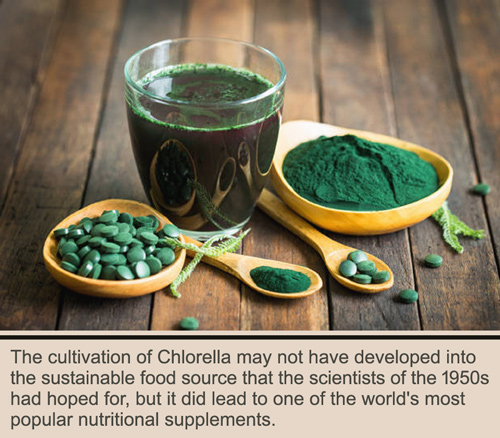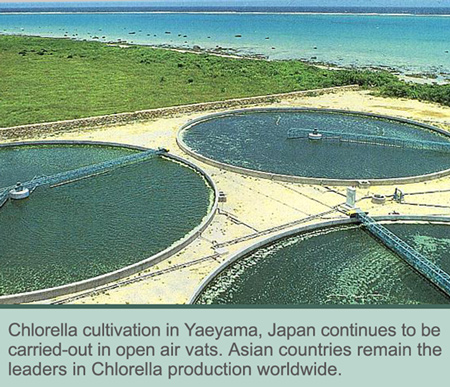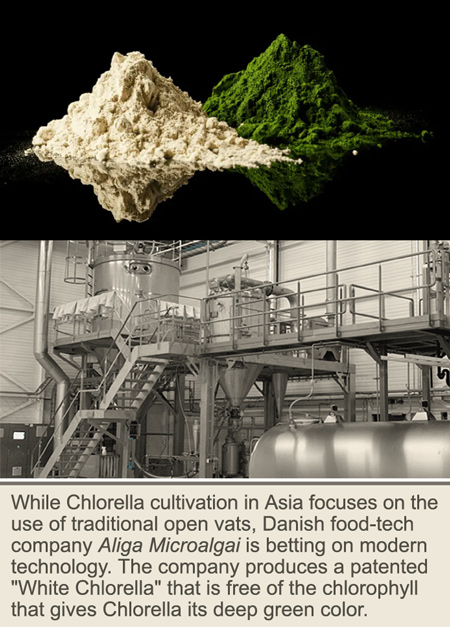If you’ve ever purchased a “healthy green dink” at a smoothie bar, it probably contained a green superfood powder that the cashier told you was called “Chlorella.”
Chlorella is a single-celled alga that is native to Taiwan and Japan. It belongs to a genus of about thirteen species of green algae of the division Chlorophyta.
When dried, Chlorella is about 45% protein, 20% fat, 20% carbohydrate, 5% fiber, and 10% vitamins and minerals.
The 10% vitamin and mineral portion includes just about every essential vitamin and mineral that humans need—including the full spectrum of B-vitamins. But that’s not all: Chlorella is also a potent detoxifier and is high in antioxidants, especially the carotenoid lutein.
In addition, Chlorella provides critical Omega-3 fatty acids, and it contains a unique component called Chlorella Growth Factor (CGF) which boosts and supports immunity.
CGF constitutes 2.5% of chlorella’s total components and is a complex of nucleic acids (DNA and RNA) which give it the ability to repair cellular, nerve and muscular tissue in the body. It increases macrophage, T-cell and B-cell activity through stimulation of the immune system and also increases interferon production. CGF also increases the numbers of white blood cells, red blood cells and platelets.
Also noteworthy is how robust the protein is in this non-animal product. The 2018 book Nonvitamin and Nonmineral Nutritional Supplements by Joana Silva and Susana Bernardino notes: “Reports on the protein of Chlorella reveal all essential amino acids required for the nutrition of heterotrophic organisms.”
No wonder Chlorella is a popular suppplement that is sprinkled on foods, mixed into green drinks, and swallowed in capsule form by the billions each day. Chlorella is also used as an animal feed supplement, in the pharmaceutical industry and in the production of cosmetics industry.
Today Chlorella is the most cultivated eukaryotic alga in the world.
But what may surprise you is the history of how Chlorella was catapulted into popularity as a nutritional supplement in the first place.
Ancient history
Your understanding of the history of Chlorella will likely be influenced by your opinion of herbal medicines. According to the “all herbs are bad” crowd at Wikipedia, Chlorella was “discovered” in 1890 by the Dutch scientist Martinus Beijerinck. In that year Beijerinck discovered a small green plant that could just barely be observed under a microscope. It was named “chlorella”, by combining the Greek word “chloros” (meaning green) and the Latin word “ella” (meaning small).
However, to those who acknowledge the role of traditional medicines, Chlorella has been around for thousands of years—observed as a thin film growing naturally in pools of water.
The populations of the Far East discovered this “slime” had medicinal properties thousands of years ago.
In China, Chlorella has been used—and is still used—to treat cancerous growths and viruses. In Japan, it is traditionally used as a treatment for gastritis, hypertension, diabetes, hypoglycemia, and asthma.
In Traditional Chinese Medicine, Chlorella is said to provide the YIN energy—bringing the imbalanced body back to balance.
Today, there are over 20 known Chlorella kinds, with the most common species being vulgaris and pyreinoidosa.
A superfood is born
One point that historians can agree on is that, unlike its sister superfood Spirulina, Chlorella has not been used for hundreds of years as a source of food that can be easily “gathered up” and feasted on. Chlorella needed a little help from modern technology to take it from the tiny quantities used for traditional medicine to a mass-produced food source that is easily digestable.
As it happens, Chlorella presents a challenging situation with its cell walls. The cell walls are extremely tough, making them indigestible by stomach acids. This severly impacts the absorption of the potent nutrients present in the alga.
This obstacle is not a problem today since technology allows the cell walls to be cracked and pulverized. This is why some Chlorella products state “open-cell” or “cracked cell” on the label.
Fortunately there was a big incentive to develop this technology—a food scarcity threat. In fact, the impetus to develop the technoglogy and overcome the obstacles faced in Chlorella production probably wouldn’t have happened if it wasn’t for the threat of worldwide starvation promoted by the scientific community starting in the 1940s.
According to Wikipedia: “Following global fears of an uncontrollable human population boom during the late 1940s and the early 1950s, Chlorella was seen as a new and promising primary food source and as a possible solution to the then-current world hunger crisis. Many people during this time thought hunger would be an overwhelming problem and saw Chlorella as a way to end this crisis by providing large amounts of high-quality food for a relatively low cost.”
With big financial incentives from the federal government, maany institutions began to research Chlorella. This included the Carnegie Institution, the Rockefeller Foundation, the National Institutes of Health, UC Berkeley, the Atomic Energy Commission, and Stanford University—to name a few.
If it sounds too good to be true…
In a situation eerily similar to today’s climate change environment, the ruling elite insisted that since meat was so costly and energy-intensive to produce, protein shortages were an issue. Increasing cultivated area alone would go only so far in providing adequate nutrition to the population. The USDA calculated that, to feed the U.S. population by 1975, it would have to add 200 million acres of land—but only 45 million were available.
Chlorella seemed like a viable option because of the technological advances in agriculture at the time and the widespread acclaim it got from experts and scientists who studied it. Algae researchers even promoted Chlorella powder as an additive to conventional food products as a way to fortify them with vitamins and minerals.
When the preliminary laboratory results were published, the scientific community at first backed the possibilities of Chlorella. The scientific publication Science News Letter praised the optimistic results in an article entitled Algae to Feed the Starving. Not to be outdone, Science Digest also reported, “common pond scum would soon become the world’s most important agricultural crop.”
A first pilot plant of Chlorella mass culture was constructed in the United States, in 1951. The first commercial plant was established in Japan around 1960, and Taiwan in 1964. By 1977, there were 48 largescale Chlorella factories in Asia.
However, the hype eventually faded away. The threat of mass starvation in the U.S. never materialized; and the promise of easy protein production via Chlorella proved elusive. Traditional farms became more efficient, while Chlorella mass-production turned out to be more time-consuming and expensive than originally thought.
Growing in popularity
But through all the trials, testing and failures—and millions of wasted taxpayer dollars—a nutritional supplement did emerge that was able to be successfully marketed by entrepreneurs in the free market.
This is not surprising for anyone familiar with Chlorella’s nutritional profile. It turns out that, once the the “tough cell wall” issue is overcome Chlorella is arguably the most nutrient-dense superfood.
According to market forecasting company Meticulous Research, the Chlorella market expanded greatly during the Covid pandemic and is expected to reach $412.3 million by 2028.
“The chlorella market is experiencing a positive impact mainly due to its key role in the immune health system. Chlorella is used as a healthy, natural, and sustainable superfood, which is in demand during COVID-19. During the pandemic, consumers demanded more food or ingredients which strengthen the immune and digestive system,” Meticulous Research wrote in their 2021 forecast.
Today over 3000 tons of Chlorella is grown in Asia, the U.S. and Europe. This is a staggering amount considering Chlorella is now considered just a niche market—as opposed to a food—and the amount produced is just for fortification and supplementing purposes.
Chlorella is one of the potent nutrients in the Pre-Conditioning Pak offered by Optimal Health Systems. Click sidebar banner ad to learn more.
– – –
Sources: American Botanical Council, Wikipedia/Chlorella, HerbalReality.com, Nonvitamin and Nonmineral Nutritional Supplements (excerpts of book via ScienceDirect.com), GlobalNewsWire.com.




